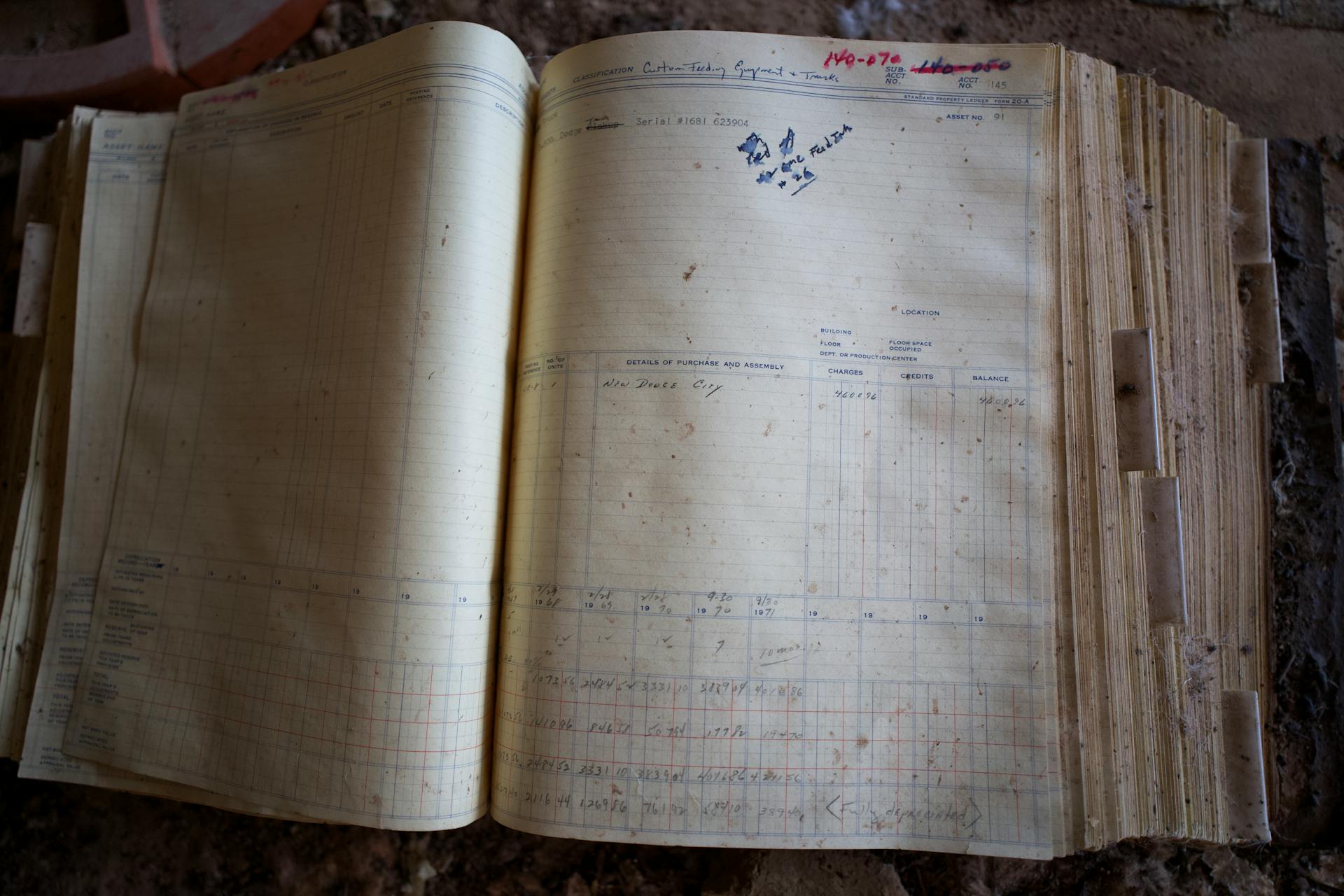
Straight line depreciation is a popular method for spreading the cost of an asset over its useful life. This method assumes that the asset's value decreases at a constant rate each year.
The straight line depreciation formula is: Depreciation Expense = (Cost - Residual Value) / Useful Life. For example, if an asset costs $10,000 and has a residual value of $2,000, and a useful life of 5 years, the annual depreciation expense would be $1,600.
To record the straight line depreciation in the accounting journal, you would debit Depreciation Expense for the calculated amount and credit Accumulated Depreciation.
Check this out: Depreciate in Value
Depreciation Methods
The straight-line method of depreciation is the most commonly used method of calculating depreciation, where the cost of the asset is divided by its useful life to determine the annual depreciation expense.
There are several other methods of depreciation, including declining balance, sum-of-the-years'-digits, and units of production, each with its own way of allocating the cost of the asset over its useful life.
The declining balance method, for example, allocates more of the cost in the early years of the asset's life, by applying a fixed percentage rate to the book value of the asset at the beginning of each period.
Depreciation Methods Explained
The straight-line method of depreciation is the most common method used to calculate depreciation expense. It's the simplest method because it equally distributes the depreciation expense over the life of the asset.
To calculate straight-line depreciation, you need three inputs: the cost of the asset, the salvage value, and the useful life of the asset. The formula for straight-line depreciation is: Depreciation expense = (Cost of asset – Salvage value) / Useful life.
The useful life of an asset is the estimated amount of time it's expected to be used before it needs to be replaced or disposed. For example, a company might estimate that a piece of equipment will last for 10 years.
The straight-line method is calculated by dividing the depreciable base (cost minus salvage value) by the useful life of the asset. For instance, if a company purchases equipment for $100,000 and estimates it will last for 10 years, with a salvage value of $30,000, the annual depreciation expense would be $7,000.
Intriguing read: How to Depreciate Equipment
There are other methods of depreciation, including declining balance and sum-of-the-years'-digits. The declining balance method allocates more of the cost in the early years of the asset's life, while the sum-of-the-years'-digits method allocates the cost based on the number of years remaining in the asset's life.
Here's a quick comparison of the straight-line method and the declining balance method:
The straight-line method is often used because it's easy to calculate and provides a consistent depreciation expense each year. However, the declining balance method can be more accurate for assets that depreciate quickly in the early years of their life.
Suggestion: Depreciation Expense Straight Line Method
Double-Declining Balance
The double-declining balance method is an accelerated depreciation method that calculates depreciation expense as a fixed percentage of the asset's book value at the beginning of each period.
This method uses a percentage that is typically double the straight-line rate, making it a more aggressive depreciation method compared to straight-line.
The formula for double-declining balance depreciation is:
The double-declining balance method is often used for assets with a shorter useful life, as it allows for a faster write-off of the asset's value.
Worth a look: Depreciated Value
Calculating Depreciation
The formula to calculate straight-line depreciation expense is (cost – salvage value) / useful life. This formula helps businesses determine the annual depreciation expense for a fixed asset.
To calculate the depreciable base, you subtract the salvage value from the purchase price. In the example, the depreciable base is $70,000, which is calculated by subtracting $30,000 from the purchase price of $100,000.
The annual depreciation expense is then calculated by dividing the depreciable base by the useful life. In this case, the annual depreciation expense is $7,000, which is calculated by dividing $70,000 by 10 years.
Intriguing read: Depreciation Expense Formula
Understanding the Concept
The concept of depreciation is pretty straightforward, but it's worth understanding before we dive into the calculations. Depreciation occurs when the value of a fixed asset diminishes over time.
This can happen due to physical deterioration, which is caused by wear and tear from frequent use or exposure to elements like rain, sun, and wind.
In other words, the more an asset is used, the more its value decreases. Functional or economic depreciation also occurs when an asset becomes inadequate for its purpose or becomes obsolete, even without any physical deterioration.
Suggestion: Depreciated Value Claim
Calculating Fixed Asset
Calculating fixed assets is a crucial step in determining the depreciation expense of a company. The straight-line method is a common approach used to calculate depreciation, and it's based on the formula: (cost - salvage value) / useful life.
To calculate the straight-line depreciation expense, you need to determine the depreciable base of the asset. This is done by subtracting the salvage value from the purchase price. For example, if a company purchases equipment for $100,000 and expects to sell it for $30,000 at the end of its useful life, the depreciable base would be $70,000.
A company can use the straight-line method to depreciate a fixed asset over its useful life. The annual depreciation expense is calculated by dividing the depreciable base by the number of years the asset is expected to be used. In the case of the equipment mentioned earlier, the annual depreciation expense would be $7,000 over a period of 10 years.

The useful life of a fixed asset is a critical factor in determining the depreciation expense. It's the number of years the asset is expected to be used before it reaches its salvage value. For example, if a company purchases equipment with a useful life of 10 years, it would depreciate the asset over that period.
Here are the key factors to consider when calculating the straight-line depreciation expense:
- Purchase price
- Salvage value
- Useful life
These factors are used to calculate the depreciable base, which is then divided by the useful life to determine the annual depreciation expense.
Journal Entries
A journal entry for straight-line depreciation is a simple yet crucial process. The credit is always made to the Accumulated Depreciation account, not the cost account directly.
To record depreciation expense, you'll debit the Depreciation Expense account and credit the Accumulated Depreciation account. This is a key principle to remember when making journal entries for depreciation.
The journal entry for depreciation can be calculated using the straight-line method, where the cost of the asset is evenly spread over its useful life. For example, if a delivery truck costs $50,000 and has a 5-year useful life, the annual depreciation expense would be $10,000.
Here's a summary of the journal entry for depreciation:
This journal entry helps companies follow the matching principle and accurately present their financial health to stakeholders.
Annual Journal Entries

Annual journal entries are a crucial part of accounting, and they help businesses accurately reflect the value of their assets over time.
To record annual depreciation, companies use a journal entry that debits the depreciation expense and credits the accumulated depreciation account. This entry is made at the end of each year to recognize the annual depreciation of the asset.
The journal entry for annual depreciation is the same every year, and it's based on the asset's depreciable base, which is the total cost of the asset minus its estimated salvage value. For example, if a company purchases a piece of equipment for $50,000 and estimates its salvage value to be $10,000, the depreciable base would be $40,000.
Here's a breakdown of the journal entry for annual depreciation:
- Debit: Depreciation Expense (equal to the annual depreciation rate)
- Credit: Accumulated Depreciation (equal to the annual depreciation rate)
For instance, if the annual depreciation rate is 10% of the depreciable base, the journal entry would be:
- Debit: Depreciation Expense ($4,000)
- Credit: Accumulated Depreciation ($4,000)
This process continues until the asset is fully depreciated, at which point the net fixed asset balance will equal its estimated salvage value.
Journal Entry Types

There are four common types of depreciation journal entries that businesses use.
The straight line depreciation method is one of the easiest ways to calculate depreciation, keeping the depreciation amount the same for each year.
Double declining depreciation is a type of accelerated depreciation method, ideal for assets that lose their value quickly in the initial years.
The units of production depreciation method takes into account the number of units an asset can produce during its lifetime.
Sum-of-the-years depreciation is another kind of accelerated depreciation method, suited for assets that lose their value quickly in the initial years of their useful life.
Here are the four depreciation journal entry methods in a list:
- Straight line depreciation
- Double declining depreciation
- Units of production depreciation
- Sum-of-the-years depreciation
Financial Reporting
Financial reporting requires accurate and timely information, which is why straight line depreciation is a crucial aspect of asset accounting.
Straight line depreciation is a method of depreciating assets over their useful life, typically expressed as a percentage of the asset's cost.
This method assumes that the asset loses value evenly over its useful life, which can range from a few years to several decades.
For example, a company might depreciate a piece of equipment over a 5-year period, with an annual depreciation expense of 20% of the asset's cost.
Residual Value

Residual value is a crucial concept in financial reporting, and it can significantly impact the depreciation expense of an asset.
The residual value is the estimated value of an asset at the end of its useful life. For example, a delivery van with an estimated residual value of $10,000 after 5 years.
This means that the depreciation expense will be reduced accordingly. The delivery van's depreciation expense would be computed as $40,000 - $10,000, resulting in a lower depreciation expense over the 5-year period.
In this case, the residual value is subtracted from the initial cost of the asset to determine the depreciation expense. This approach ensures that the asset's value is not overstated, and the depreciation expense is more accurate.
The residual value can be a significant factor in determining the depreciation expense, and it's essential to consider it when calculating depreciation.
Financial Statement Presentation
The income statement and balance sheet are two key financial statements that present the financial position and performance of a company.

The carrying value of an asset is presented in the balance sheet, and it decreases over time due to depreciation.
Depreciation is the reduction in value of an asset due to wear and tear, obsolescence, or other factors.
Here is an example of how depreciation is presented in the income statement and balance sheet:
The carrying amount of an asset will never fall below its residual value, which is the amount that can be recovered even when the asset is no longer being used.
Specific Assets
Depreciation is a process of allocating the cost of an asset over its useful life.
The cost of an asset is allocated over its useful life through depreciation.
Different methods of depreciation are used, depending on the type of asset and the company's accounting policy.
Depreciation is used to account for the decrease in value of an asset over time.
The method of depreciation used depends on the type of asset, such as tangible assets or intangible assets.
You might enjoy: Is Straight Line Depreciation a Fixed Cost
Frequently Asked Questions
How is depreciation treated under the straight line method?
Under the straight line method, depreciation is calculated by deducting a fixed amount from the asset's value each year, evenly spread over its useful life. This results in a steady decrease in value over time.
Sources
- https://finquery.com/blog/straight-line-method-depreciation-explained-example/
- https://xplaind.com/480282/straight-line-depreciation
- https://www.highradius.com/resources/Blog/accounting-entry-for-depreciation/
- https://www.accountingverse.com/accounting-basics/depreciation-expense.html
- https://accountingforeveryone.com/what-is-depreciation-differing-types-of-depreciation-and-their-journal-entries/
Featured Images: pexels.com


